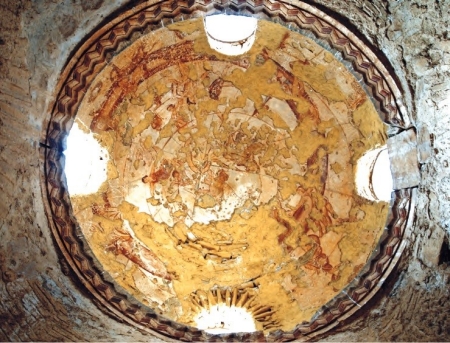One approach to this problem is to track the development and transformation of iconographies derived from the shared late antique substratum at the moment of emergence of distinct medieval traditions. For example, Roman and late antique artistic cultures produced a variety of techniques for imaging Ptolemaic cosmology, many of which were reproduced in the major early medieval successor states: Frankish/Carolingian, Byzantine, and Islamic/Umayyad. The early medieval reception of Ptolemaic imagery was marked by iconographic and stylistic conservatism. Sagittarius in a Byzantine or a Carolingian manuscript looks more or less like Sagittarius on the cupola of an Umayyad bathhouse, and all would have been immediately recognizable to a Roman viewer of seven hundred years before.
However, these stylistic and iconographic continuities conceal a series of functional transformations. For the purposes of my dissertation research, two functions of Roman images of the cosmos are of primary importance: the epistemological (images as a means of transmission of knowledge about cosmology) and the symbolic (images as shorthand for the cosmos within broader signifying systems). Examples of the former type include images in school texts and surveying manuals, while an example of the latter type is the palace of Septimius Severus, in which the emperor’s horoscope was depicted as a signifier of his unique destiny.
Carolingian and Byzantine monuments are marked by the continuing relevance of the epistemological function. The very brief period between c. 800 and 820 witnessed intensive production of cycles of constellation imagery in Carolingian scriptoria, most significantly in the context of manuals for the reckoning of time. In Constantinople, a scriptorium, almost certainly imperial, produced a richly illuminated compilation of astronomical charts around the year 750, but, in striking contrast to the Carolingian situation, this work had no issue, and an independent tradition of cosmological imagery never developed in Byzantium. Thus continuity of the epistemological function must be qualified by a distinction between two economies of knowledge: a distributive economy in the Carolingian world, which encouraged the transmission and reproduction of cosmological imagery as a means to forge an elite identity; and a jealous economy in the Byzantine world, in which depiction of the cosmos became a site of contest between emperors and elites, and cosmological images were hoarded as potential sources of power.
Carolingian and Byzantine works also evidence the near abandonment of the symbolic use of cosmological imagery, especially in political contexts. This constitutes a major distinction from the Umayyad material. In the frescoes in the bathhouse and reception hall complex at Qusayr ‘Amra, for example, the cosmological frescoes of the caldarium dome form part of a complicated assemblage of iconographies, many of which can be related to contemporary panegyric texts produced in the caliphal court.
These functional shifts in the production of Ptolemaic imagery suggest a way of thinking more broadly about the development of distinct early medieval artistic traditions. The emergence of divergent economies of knowledge in the Byzantine and Carolingian worlds and the continuing symbolic employment of cosmological imagery in Umayyad political contexts can be connected to the differing relationships between state and society that also emerged in these three spheres. A focus on function within the context of comparative historical sociology emerges as an approach capable of reintroducing the concept of distinct traditions in early medieval art while avoiding the essentialisms that tainted earlier theoretical approaches to the subject.
Members' Research Report Archive
Images of the Ptolemaic Cosmos and the Problem of Early Medieval Art
Benjamin Anderson [Bryn Mawr College]
David E. Finley Fellow, 2009–2012
Disciplinary geographies of the early Middle Ages mirror the shifts in Mediterranean geopolitics that followed the collapse of Roman hegemony and the emergence of a variety of successor states. If a Romanist is charged with mastery of European, west Asian, and north African material, a medievalist is likely to adopt a geographically delimited specialization: Western medieval, Byzantine, Islamic. These divisions have been justly criticized for obscuring the persistence of a shared late antique heritage and the extensive artistic exchanges that occurred between early medieval states. Nevertheless, the wholesale adoption of an undifferentiated “medieval Mediterranean” art history risks discarding the analytically useful concept of distinct artistic traditions. The dialectical tension between the persistence of late antique heritage and the emergence of distinct cultural identities, mediated in part through artistic production, constitutes a central problem of early medieval art.

Dome frescoes depicting constellations, Qusayr ‘Amra (present-day Jordan), first half of the eighth century. Author photograph